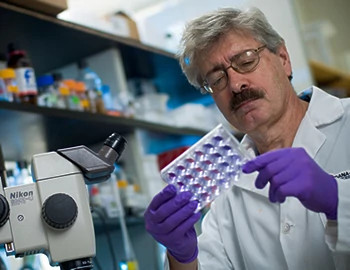
Targeted Therapies/Precision Cancer Medicine
Each brain tumor carries a distinct collection of genetic abnormalities that help determine the tumor's behavior, the patient's prognosis, and, potentially, which drugs or combinations will be most effective. And while certain genetic conditions increase the risk of developing glioblastomas, the majority of tumors are due to mistakes in the genetic code of normal brain cells. Some of these abnormalities are caused by massive chromosome damage, others by mutated genes and proteins.
Identifying the mutations in brain tumors that can serve as molecular targets for "smart" drugs is a significant part of our research focus. At Dana-Farber Brigham Cancer Center, our goal is to develop molecularly targeted agents precisely aimed at the abnormal DNA in tumor cells. Scientists are hopeful that tumors will be less likely to develop resistance to these smart drugs, thereby improving outcomes and quality of life.
Through the advanced genomic testing performed on patients’ tumors at Dana-Farber Brigham Cancer Center, our team is able to pinpoint the specific mutations in a patient’s tumor, allowing us to tailor treatment regimens to individual tumors.
Our researchers are investigating therapies that can target:
- IDH: IDH is one of the most common mutations in grade II and III gliomas. A mutation in the IDH gene results in increased levels of a chemical called 2-HG. Researchers are studying a specialized MRI technique called MR spectroscopy to determine whether glioma cells are overproducing 2-HG and the effectiveness of drugs that block the production of this chemical. Currently, there are four ongoing clinical trials at Dana-Farber/Harvard Cancer Center using targeted molecular drugs (AG120, AG881, IDH305, and AG221 [14-486]) directed against various IDH mutations in both low and high grade gliomas.
- Epidermal growth Factor Receptor (EGFR): Approximately 50 percent of glioblastomas have extra copies of the EGFR, and 20 percent have a specific mutation of the receptor called EGFRvIII. Currently there are ongoing trials of targeted drugs directed against EGFR, such as ABT 414.
- PI3K: Mutations in the PI3K pathway – a family of enzymes that are involved in cell growth – are common in brain tumors. Our researchers are using sophisticated models to test experimental compounds that inhibit specific members of the PI3K pathway. Trials using potent inhibitors of this pathway in combination are planned.
- Olig-2: This protein plays a key role in the developing brain. In adulthood, Olig-2 is relatively dormant, but when the protein is abnormally activated, it can enable cancer to develop. It has been shown that Olig-2 is active in 90 percent of brain tumors, including glioblastomas, and contributes to the resistance of the tumors to radiation therapy, making it a good potential target for designer drugs.
Through clinical trials, we are evaluating therapies that target these pathways. We are testing single agents as well as a combination of agents that block several malignant pathways simultaneously.